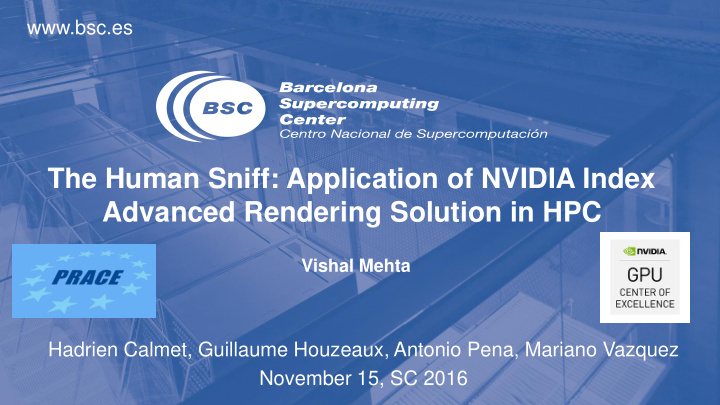



www.bsc.es The Human Sniff: Application of NVIDIA Index Advanced Rendering Solution in HPC Vishal Mehta Hadrien Calmet, Guillaume Houzeaux, Antonio Pena, Mariano Vazquez November 15, SC 2016
Barcelona Supercomputing Center Computer Science – Programming Models, Tools, Big data Computer Applications – Biomechanics, Oil & Gas, renewable energy Earth Science – Climate modeling, Geophysics Operations – HPC infrastructure and services Life Science – Genomics, Bioinformatics BSC Booth 2511 2
HPC applications @ BSC Volcanic ash dispersal Drug delivery Bio-Mechanics Fusion Reactor Climate Modeling Sniff 3
SCIENTIFIC ASPECTS
Breathing and Nasal flow Normal breathing rate 20-30 l/min, which is around 12,000 liters a day. The flow is dominantly laminar due to nasal structures, with turbulences and vortexes a certain locations. The air flow rate during breathing can reach 18m/s to 32 m/s during sniff, which the rate of Type one Tropical Cyclone. The absolute atmospheric pressure drops almost to zero. 5
Anatomy and Data Acquisition MRI imaging with 0.39x0.39 mm pixel size, slices with 1.3mm thickness and 0.7mm spacing 6
Deposition and Tracking Particles deposition depends on particle size. Depends on nasal mucosa level often difficult to simulate Particles in nano scale often get drifted by Brownian motion Less 2% particles reach the lungs. 7
MEDICAL AND PHARMACEUTICAL APPLICATION
Targeted and Efficient delivery In most cases a broad particle deposition on mucosal surface in the nasal cavity . In sinusitis and nasal polyposis , targeted delivery to the middle and superior meatuses where the sinus openings are, and where the polyps originate is effective. Olfactory region is desirable for nose-to-brain delivery. Injection into blood stream requires more particles to reach the lungs. 9
A step towards Personalized Medicine Faster and accurate simulations based on patient MRIs, will allow more efficient treatment of chronic diseases. Injectors can vary from pipette and catheter for liquid dosage to squeeze bottles and spray pumps. Simulations will allow to pick an efficient method of delivery, design personalized injectors and drug composition for targeted delivery. 10
SIMULATION CHALLENGES
ALYA MultiPhysics High Performance Computational Mechanics Multiphysics suite MPI + OpenMP + CUDA Dynamic Load Balancing CFD, solid, electromagnetism, combustion, heat transfer, Lagrangian particles, etc. One of the two PRACE EU benchmark suite 12
Particles Coupled in ALYA Laminar Fluid Flow with active turbulence sites Drag force and Brownian motion Semi-implicit Newmark-beta integration scheme (Newton-Raphson) Adaptive time step strategy Particle diameters ranging from 1 to 150nm 50M finite elements and 100k particles. 13
Big computation and Big data A coupled fluid and particle flow takes about 18 hours on 500 nodes (8000 cores). It generates about 8-10 Tera bytes of Lagrangian particle information in Sparse volume compressed format. Data is stored in key-value format in Cassandra for in-situ analytics. 14
NVIDIA INDEX ADVANCED RENDERING SOLUTION
NVIDIA Index for HPC data:: Big Visualizations Parallel Rendering and Composting of Tera Bytes of volumetric data (OpenVDB) Allows interactions with the data set, for better insight in the data. Supports triangular surface meshes with professional visualization features. 16
Simulation Features: Re-circulation Recirculation in throat, a phenomenon that reduces particle velocities and helps in throat treatment. 17
Simulation Features: Deposition and Transport More than 90% particles get Deposition due to flow in the deposited in the nasal cavity. respiratory track 18
Summary Simulations in targeted medicine application for respiartory system, require massive computation and generates significant quantity of data. An ecosystem around in-situ and distributed analytics and visualizations, will reduce time to results. Faster simulations, Data analytics, and Visulizations through GPUs is a step towards personalized medicine.
www.bsc.es Thank You Keep Breathing BSC Booth 2511 20
Recommend
More recommend